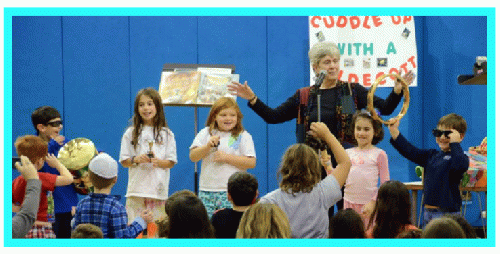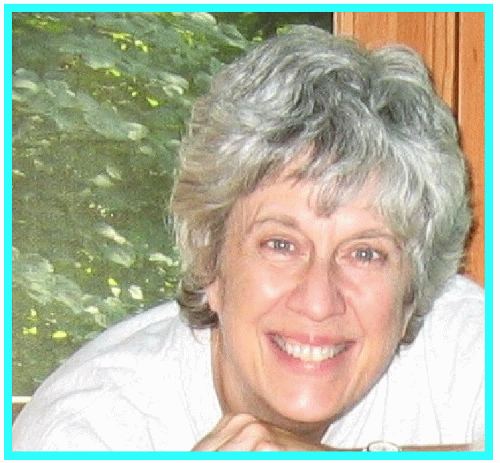My guest today is retired elementary teacher and storyteller, Nancy Shapiro-Pikelny. Welcome to OpEdNews, Nancy.
Joan Brunwasser: I love stories. Who doesn't? So, naturally I'd like to hear about how and when you got hooked.
Nancy Shapiro-Pikelny: In the summer of 1995, my son* needed a ride to West Virginia to attend a week-long banjo workshop at the Augusta Heritage Center. I was his chauffeur on the 800-mile trip. And thanks to the principal of my school, Charlotte Glass, who believed in supporting her teachers' growth and continuing education, I received financial backing to take a workshop while I was there. There were classes in music, quilting, blacksmithing... I chose storytelling. And it changed my life.
JB: So, you could say that music brought you to storytelling. Why did you choose that workshop? And what happened?
NSP: As the granddaughter of a tailor, you'd think that the class in quilting would have been perfect. But I have zero aptitude with a needle and thread. So, a storytelling workshop seemed logical. I loved reading and I loved books. But I discovered during my week in West Virginia that storytelling has a different kind of power than the written word. The live relationship between teller and listener was something that might enrich the world of my second grade classroom. And it did. Some of my students who struggled in reading or writing began to shine when given chances to tell their stories. They became stars! And personally, I began to understand my father's gifts - how he captivated us telling us stories of his childhood and WWII. And now years later, this legacy of story is something I am trying to pass on to my grandchildren.
JB: We all feel the pull of stories. They literally speak to us. But there's a big leap between being a listener and becoming the teller. How did you get the courage to begin that transition?
NSP: You are right about courage. I was never the kind of person who wanted to be the center of attention or who would grab a microphone. But I became more confident if I really knew the story I wanted to tell. My teacher, Connie Regan-Blake, emphasized having clarity and comfort with phrases or rhythm of the story, especially the intro to the story and how you wanted to end. Not in the sense of memorizing a story. But knowing a story "by heart" in a different way. Knowing the essence of a story from within. One of the keys I learned was that my role was in service of the story. It was not about me as the storyteller. If I remembered that, my courage grew for the sake of the story. And this wasn't just for stories with deep moral issues or big life lessons. It was also for the tales that people simply need. To laugh. To be entertained. To escape from worries and fear. Everybody needs that.

2013 celebration of Caldecott book awards at Solomon Schechter Day School, Northbrook
(Image by Nancy Shapiro-Pikelny) Details DMCA
JB: Indeed we do. Especially now. I identify with so much of what you just said. The role of the storyteller, namely the story, versus the person of the storyteller. I had a similar issue when I stretched my comfort zone to become an interviewer. It became easier over time as I began to see my role as an almost invisible conduit between the interviewee and the ultimate reader.
Tell us about how you go about engaging a group that may or may not be familiar with you before the storytelling. For instance, I just listened to one of your stories: The Chicken in the Library. Give us the backstory. Who was your audience? What was the context? Clearly, they were entranced by the story and jumped in with youthful enthusiasm.
NSP: The event was to celebrate Jewish Book Month. The audience was Kindergarten through 2nd grade at a local synagogue. The 'kernel' of The Chicken and the Library was a joke I had heard. But with elaboration of the plot and audience participation, it became a sweet little story. It was a great way for me to show the children the link between books and telling - going from the page to the stage. I actually pulled books out of a backpack (just like the chicken did in the story). I showed them one particular book based on an old folktale "Joseph Had a Little Overcoat" by Simms Taback, which won the Caldecott Award a number of years ago. I loved this old story so much that it inspired me to create my own version "Rina's Blanket" which I then told to the children.
JB: I just listened and it was lovely! I found myself admiring the cadence and repeating the key phrases in the story aloud, feeling a little silly at the same time. It's very catchy, isn't it? There's a bit of bonding going on, even when it's merely a recording with no visuals. Talk to us about that process, please. I imagine it's not always so easy to connect. What happens when it's not? What do you do?
NSP: Children are very honest in their responses. If their attention might be wandering and they are getting restless, I try to improvise: either streamline the story or insert a song or chant that they can join in that might fit in that moment of the story. Sometimes I ask for volunteers to come up and be characters in the story. That can work. But it can also be a total disaster. I do try to be aware while telling a story that I can't truly know what another person is thinking. So if I notice a woman with her eyes closed, she might be bored or tired or completely engrossed in the tale. I do know that both children and adults come to a storytelling gathering with a pure desire for the teller to succeed - a pure need for stories. So, if I come prepared and pay attention to the faces in front of me, the story almost always wins out.
(Note: You can view every article as one long page if you sign up as an Advocate Member, or higher).






